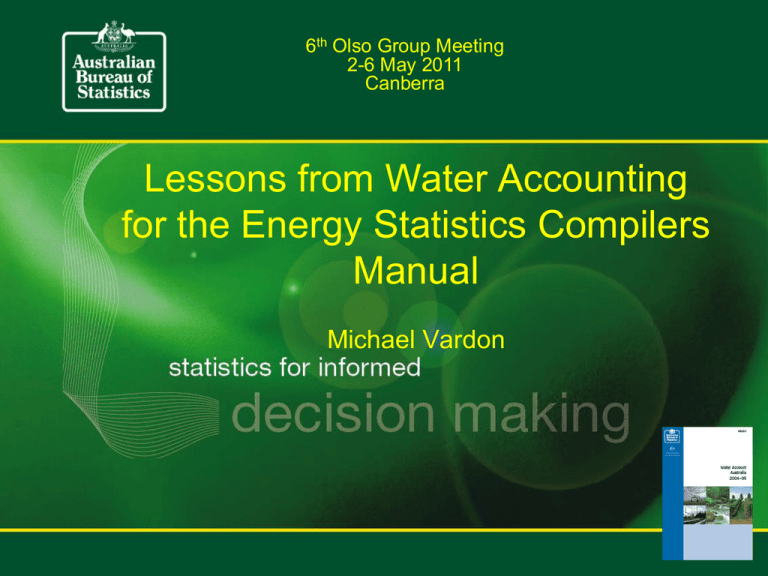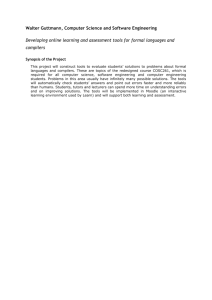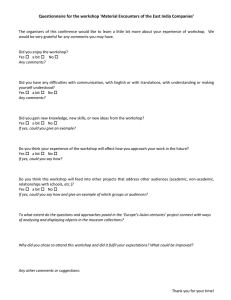Lessons from Water Accounting for the Energy Statistics Compilers Manual Michael Vardon
advertisement

6th Olso Group Meeting 2-6 May 2011 Canberra Lessons from Water Accounting for the Energy Statistics Compilers Manual Michael Vardon Lessons • • • • There are many audiences Do not for get the basics Emphasise the basics Output tables are not usually good for data collection • Allow for change Audiences for information: from data to indicators Headline indicators Data users Indicators on specific subjects or industries Decision makers & wider public Indicators Managers and analysts Researchers Environmental Accounts and other aggregations Data items Information Audiences • The audiences vary in terms of background – Compilers in statistics offices as well as other agencies – Mandate and institutional arrangements of compilers – Level of experience of individuals doing collection – History and sophistication of agency Basic statistical process are important and must be emphasised Dimensions of data quality*: Relevance – does the data answer the questions? Accuracy – how closely does the data represent the real word? Timeliness – is that data available in time for decision making? Accessibility – how are the data accessed? Interpretability – can the data be easily interpreted and used? Coherence – how does the data relate to other data? *Source: Statistics Canada: http://www.statcan.gc.ca/bsolc/olc-cel/olc-cel?lang=eng&catno=12-586-X Important issues to emphasise for new compilers • Institutional arrangements • Process of development – (Including identifying and acknowledging existing data providers and identifying key questions not currently addressed by data) • Importance of data collection strategy • Key data collection considerations – Frame creation and maintainance – Design of collection instrument – Data collection is on-going 2004 2001 1998 1995 1992 1989 1986 1983 1980 1977 1974 1971 1968 1965 1962 1959 1956 1953 1950 1947 1944 1941 1938 1935 1932 1929 1926 1923 1920 '000 Hectares It is not the first time you produce data that is important Area Irrigated, Australia - 1920-2005 3,000 2,500 2,000 1,500 1,000 500 0 Output tables are not usually suitable for data collection Australian experience with business surveys • Good form design is essential (see Dillman) • Use language and concepts familiar to those expected to complete form – Do not expect them to understand the concepts required to complete energy balances or energy accounts Diagrams can be helpful • In explain concepts in manuals and could be useful in data collection and presentation B. 1. P reci pit ati on C.1. E vapotranspirati on D. 3. B. 2. Inf low from neighboring terri tories D. 4. A. 1. S urf ace water A .1.1. A rt if ici al reservoirs A .1.2. Lakes A .1.3. Rivers A .1.4. Wet lands A .1.5. S now, ice and gl aciers D.2. A .2. Groundwater D.1. C.2. 1. Outf low t o nei ghbori ng t errit ori es Ter r itor y S oil water C. 2.2. Outf low t o t he sea 10 Lessons from Environment Accounting for Improving Biodiversity Monitoring Lesson 1 – Build on the past Lesson 2 – Must have sound institutional arrangements and legal basis Lesson 3 – Learn by doing and accept what you have Lesson 4 – Regular and ongoing beats infrequent and ad hoc Lesson 5 – Need to build capacity Lesson 6 – Integration of biodiversity data with other data is critical Lesson 7 – Determining what to measure and how to measure it Lesson 8 – Deciding how much is enough for effective monitoring Lesson 9 – Ability to access and interpret data Lesson 10 – Defining the questions and flexibility Key Australia – physical water supply and use, 2008-09 (GL) Wastewater Water Reuse water ? ? 79 Sewerage ? 103 ? 7 ? 27 ? 9 Water Supply ? 87 2 ? 143 3267 Agriculture 3626 515 ? 339 Mining 715 ? 228 Manufacturing* 336 334 944 Electricity 44841 12 1594 Other industries 320 44484 Households 172 93 ? 722 Inland Water Resources The Sea 1163 * Note shown is the supply of distributed water and reuse water by mining and manufacturing, 25 GL in total. 33 9336 Need to be able to innovate and have access to improved methods • A hard copy publication is not the end of the process • A knowledge base for recording country practices • A forum for on-going interaction of technical experts


